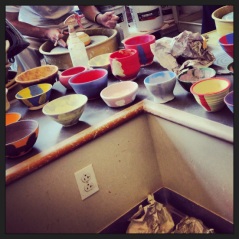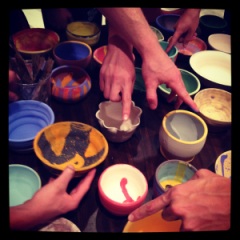It’s 6:30 PM as I start to write this. I’ve angled my laptop so I can keep an eye on the cooling kiln temperature – 708°F and dropping slowly. I want it to cool enough that I can unload and reload tonight before I go home and collapse. This might be wishful thinking.
The cycle of my life in the weeks leading up to an event like Empty Bowls revolves around kilns. Loading, unloading, cooling, stilting, grinding. Band-aids decorate my hands, covering small cuts caused by glaze chunks and debris. Often, I don’t even notice that I’ve been cut until I see blood on one of the pots. Then I’m at the sink disinfecting my cut and the bowl at the same time, wondering how I missed something that could be so bright red.
 As I’ve been glazing and working and unloading and loading – often alongside my students, although I don’t allow them to load kilns – I’ve been thinking about some writing by my friend Dave Griffith. Dave recently wrote a two-part post over at Image Journal that questions the apparent lack of successful writers and artists who identify themselves as Catholic. He is beyond eloquent in his exploration of the schism between the Church and the literary arts – written in response to another writer – and I won’t make any pretense to his skill or depth.
As I’ve been glazing and working and unloading and loading – often alongside my students, although I don’t allow them to load kilns – I’ve been thinking about some writing by my friend Dave Griffith. Dave recently wrote a two-part post over at Image Journal that questions the apparent lack of successful writers and artists who identify themselves as Catholic. He is beyond eloquent in his exploration of the schism between the Church and the literary arts – written in response to another writer – and I won’t make any pretense to his skill or depth.
To tell you the truth, I hadn’t really even considered the problem before.
But now that it’s knocking around in my mind, the idea is a striking one. For so long, the story of Catholicism was told through the arts. Just stroll any renaissance painting gallery, or browse the first three-quarters of Gardener’s Art Through the Ages. Art was how the theoretical became tangible, and the artist’s vision shaped how people understood important stories. Now this link is broken – and you’re certainly not seeing much Catholic art in Art News. If religion does enter the story, it’s through the lens of artists who are cynical or provocative about it. The writer to whom Dave is responding – Dana Gioia – cites this cynicism:
“…for the arts world, the loss of a transcendent religious vision, a refined and rigorous sense of the sacred, the breaking and discarding of two thousand years of Christian mythos, symbolism, and tradition has left contemporary American art spiritually diminished. The shallow novelty, the low-cost nihilism, and the vague and sentimental spiritual pretensions of so much contemporary art—in every medium—are the legacy of this schism, as well as the cynicism that pervades the arts world.”
Ouch.
I was raised Catholic, and I still try to practice. I have a lot of questions about the Church, and we sometimes disagree. But I don’t argue too loudly. I teach at a Catholic school, my extended family is quite devout, and I generally find too many good things about the institution to spend much time dwelling on the bad. Also, I’m excited about the new guy. This Pope Francis says such unusual things for a Church leader. Like:
“It is true that going out on to the street implies the risk of accidents happening, as they would to any ordinary man or woman. But if the church stays wrapped up in itself, it will age. And if I had to choose between a wounded church that goes out on to the streets and a sick, withdrawn church, I would definitely choose the first one.”
His words remind me of my breakup with Art. It seems to me that contemporary art and the Church that Francis is prodding have quite a bit in common. Both institutions, when unchecked, have a tendency to hide behind walls. Quiet, isolated, unreal – words that could describe the church I grew up attending, or a museum gallery on a weekday afternoon. Exclusionary? Check that box, too. A church that is does not embrace diversity and hides its abuses has something in common with an artworld that insulates and hides its own corruption, or reserves excellent programs for only those with leisure and wealth to afford them.
And yet, I still practice my faith – albeit more sporadically than when I was under my parents’ roof – and I still involve myself with art – albeit more often as craft, or as a war of definitions. And like the kiln I wish would cool faster, I feel this constant sense of urgency as I make and teach. It’s like I desperately want to connect my ideals of art and faith back together, to serve each other, because it feels like that is what they should do. Dave writes about this on the pulse of how good things can be – he teaches at a school where “no one is waiting for the next few innovators to come along, because there is a sense that everyone here is an innovator.” It’s not a religious school, he claims, then caveats that it is, sort of, in the art-as-incarnation sense, in the constant renewal and shared value of artistic vision.
I’ll admit that my affectionate jealousy of his new role may be fueling some of these thoughts. But this is his paragraph that I’ve been repeating to myself as this studio work goes on and on:
“Waiting creates a situation that breeds philistinism; a sense of not good enough; a sense of who do they think they are? In other words, waiting creates complainers and explainers, instead of do-ers. And that kind of attitude will just prolong this torpor. I know because I’ve fallen into it, too.”
Okay, you have to wait for some things. I can’t unload the kiln at its current temperature of 538°. But lately I’ve caught myself doing too much complaining and too much explaining, and I wonder if it’s because I’ve picked up a habit of waiting. Waiting for more time to be an artist. Waiting for the money to be there, or a ‘patron’ of the sort Griffith and Gioia seek for Catholic writers. Waiting for someone to write the words I need to read, to create the vision I need to follow, or to open doors that seem shut. Waiting to be acknowledged. Waiting to be a better teacher.
Developing a habit like this is something like my bandaged kiln cuts. I’m not even aware that I’ve changed into someone who is less a do-er, until I see the effects on my work. I won’t dwell on it here, but I have seen those sour effects, and felt ensuing doubt about my personal and professional directions.
But the backbreaking and soul-shaking work of a project like Empty Bowls might some attempt to pull myself out of the slump. Like the Church that Francis describes, my students and I are a little wounded and a lot tired after nearly six months of working. Like the outreach he suggests, our process has been ripe with accidents, often tiptoeing around failure. It’s a gritty project – messy in practice, sometimes tumultuous in outcome. Our art will go back out into the streets, leaving with its new owners and funding an organization embedded in helping the neediest citizens of the city.
 I don’t want to call this an Art project (capital-A) – but there is something in the practice of talent-for-good that jolts me and pushes me back into thinking forward. There’s something about my students who have spent their Saturdays working in the studio (mostly) without complaint and with generous spirits that makes me hopeful for the future of making. There’s something about opening each kiln and knowing that the work inside will soon do its own outreach that makes me reconsider what (A)rt can actually be.
I don’t want to call this an Art project (capital-A) – but there is something in the practice of talent-for-good that jolts me and pushes me back into thinking forward. There’s something about my students who have spent their Saturdays working in the studio (mostly) without complaint and with generous spirits that makes me hopeful for the future of making. There’s something about opening each kiln and knowing that the work inside will soon do its own outreach that makes me reconsider what (A)rt can actually be.
My Church is an activist church, one that gets its hands dirty in good works, and doesn’t sit behind a desk or wait for the institution to tell it what is right. And I’m learning that the Art I most appreciate is activist art – relevant to a fault, connected to and challenging the world, helping others whenever and however it can. I’m finding myself more and more resistant to any art form – visual, literary, performance, yet-to-be-invented – that sits quietly and waits for viewer or patron support. And I resist the Church when she seems to expect me to sit passively and wait for the service to be over.
There’s no more time to wait – the kiln has cooled to 225°F, our event is in two days, and there is so much to do. Dave challenges me to the “belief that we are our own light, a belief explored and critiqued in our most lasting art.” If I’m doing it right, if I’m doing things fully with the heart and tools I’ve been given, there’s no need to wait. Patronship and support are obvious, can’t-say-no conclusions. They are a necessary part of the small-a art work itself, in its relevance and relationship to the world.







it’s funny, i find so much bad in the Church that i don’t spend much time dwelling on the good.
it’s the absence of goodness in my upbringing as a Catholic that pushed me into art. since becoming un-Catholic around age 16, i’ve never felt a spiritual void because art stepped in and filled that void. i’m grateful for that.